An Evaluation of Legacy from the Glasgow 2014 Commonwealth Games: Post Games Report
This report is the first post games legacy evaluation report for the XX Commonwealth Games it aims to generate learning for ourselves, future bidders and hosts, and to add to the international literature
7. Regeneration Legacy
7.1 This chapter sets out the evidence to date that helps answer the following question in the Pre Games Report:
What effect have the Games had on the lives of the community in the area of Glasgow’s East End most directly affected?
7.2 The chapter addresses the question of whether the Glasgow 2014 Games investment, embedded in a wider regeneration programme, has contributed to physical, environmental and socio-economic improvement for those living in the areas of the East End of Glasgow most affected by the Games.
7.3 Regeneration in the East End relates mainly to the Sustainable theme of the Scottish Government’s legacy framework. It also relates primarily to the Prosperous theme under Glasgow’s legacy framework, which has as one of its outcomes to improve the physical appearance of Glasgow, particularly the East End.
7.4 Evidence for this section comes from a range of sources, but in particular includes the latest data available from the GoWell East longitudinal household survey of residents in the East End of Glasgow. GoWell East surveys the communities in the East End of Glasgow which are situated closest to the main Commonwealth Games sites, where residents may benefit from, or be otherwise affected by, the considerable amount of physical area changes (house building, road construction and upgraded sports facilities), as well as associated social and economic changes linked to the Games.
7.5 The study area was surveyed in the summer of 2012, with 1,015 adult householders interviewed across the six communities on that occasion. The aim of the post Games survey was to follow up as many of these baseline survey participants as possible if they remained living in the study area. Of the achieved baseline wave 1 sample, 41% of participants also completed wave 2 of the survey, from which a longitudinal dataset of 414 participants within the East End of Glasgow was formed. All findings presented in this chapter are based on an analysis of the baseline and follow-up survey responses from the 414 members of an East End longitudinal cohort, constructed through data-linkage between the two surveys.
7.6 This longitudinal cohort of adult householders is not representative of all adult residents in the study area in all key respects. Nonetheless, the study provides an indication of how a substantial group of residents have responded over time to the Games and other changes brought about by regeneration in the area[78].
The wider evidence base
7.7 The updated evidence review that accompanies this report maintains that major sporting events can leave long term legacies in terms of regeneration. The review cites evidence that events can speed up and extend regeneration plans and thereby act as catalysts for accelerated socio-economic development where large capital investments are made. However, these need to be linked to the city's wider plans and objectives, rather than be delivered as stand-alone initiatives. The need to engage communities in the regeneration process is also highlighted as key to long term successful regeneration.
7.8 Two key potential problems around event led regeneration are raised in the literature: the development of infrastructure that is too focussed on the Games time period alone and widespread or large scale displacement of local populations.
7.9 However, the use of vacant and derelict land and remediation of contaminated land provides a way of minimising the negative impact. Rather than forcing existing communities to relocate, using land that is disused can instead positively develop the local physical environment.
Glasgow 2014 Legacy Investment and Programmes
7.10 A number of legacy investments and programmes are specifically focussed on the East End of Glasgow and neighbouring South Lanarkshire. Figure 7.1 presents a distillation of the key types of intervention funded by Games partners. Broadly, they include the completion of key Games requirements in terms of venues and the Athletes’ Village, and wider attempts to leverage benefit from the Games by accelerating regeneration efforts, greenspace improvements and transport improvements.
Figure 7.1. Key Regeneration Legacy Interventions
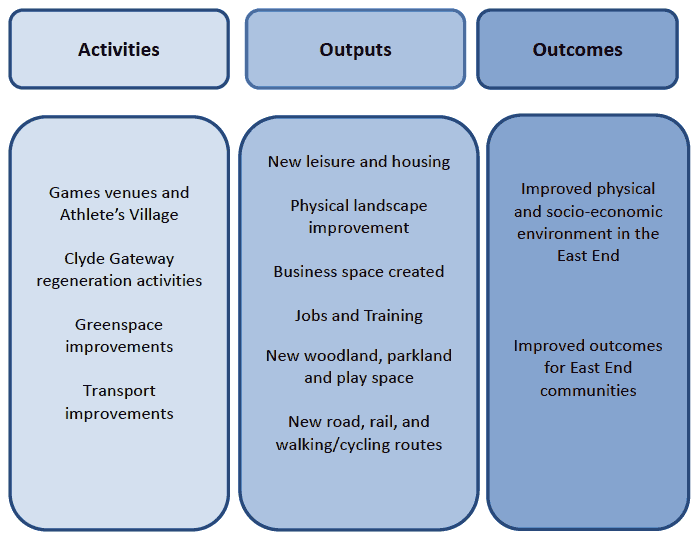
7.11 As outlined in previous chapters, the preparation for the Games involved the development of seven major new and improved sports infrastructure projects around the city. Three of these developments took place in or adjacent to the East End: the Emirates Arena and Sir Chris Hoy Velodrome; Tollcross International Swimming Centre; and the Glasgow Green National Hockey Centre.[79]
7.12 Although not directly related to legacy investment, it is important to also note that a number of smaller sporting and physical activity facilities in and around the East End area were also improved around the same time, partly to compensate for the closure of Tollcross during its refurbishment.[80]
7.13 Clyde Gateway Urban Regeneration Company (URC) is responsible for Scotland’s largest regeneration programme. It was launched six weeks after the Games were awarded to Glasgow to drive forward the bid commitment that the Games would be a catalyst for the physical, economic and social transformation of Glasgow’s East End and neighbouring South Lanarkshire.
7.14 Over the past five years, Clyde Gateway URC, with partners, has refurbished historic sites, made improvements to the public realm, created new business space, reclaimed contaminated industrial wasteland and is nearing completion of a major new park and woodland for the communities in the East End and South Lanarkshire.
7.15 In addition to this physical regeneration, Clyde Gateway is delivering a range of employment and training projects to support people into work, many for the first time.
7.16 A further £600,000 of funding for Clyde Gateway was announced by the Scottish Government in March 2015. Funding will be used for employment and education initiatives and to promote physical activity in school pupils.[81] Partners have reaffirmed a collective commitment to the regeneration of the area to ensure an enduring legacy and recognise that success will only be achieved if communities are themselves at the heart of the regeneration.
7.17 A £1 billion programme of Games-related transport infrastructure projects has included improvements to the M74 in the East End, the construction of a new dual carriageway known as the Clyde Gateway and the refurbishment of the Dalmarnock Railway station.
7.18 In addition to physical infrastructure and environmental improvements, there are a range of other legacy programmes including employability, cultural and physical activity programming and interventions taking place in the East End.
7.19 For example, a report by GoWell East on the likelihood of an active legacy for residents in the East End[82], identified a total of 39 relevant legacy programmes in operation. The role of these programmes ranged from improvements to sporting facilities to support for the development of sports clubs, events, coaching and volunteers to stimulate participation in sport and physical activity; interventions to promote physical activity in schools and several aimed at improving the physical environment intended to support physical activity and active travel through better designed environments.
Evidence to date on Games effect
7.20 The GoWell East study area runs from Saltmarket and High Street in the west to the edge of Tollcross Park in the east, including the six communities of Bridgeton, Calton, Camlachie, Dalmarnock, Gallowgate and some of Parkhead . The area is broadly similar to the Glasgow City Council East End Local Development Strategy area.
7.21 Altogether, it covers an area of 623 hectares with over 10,000 houses and a population of nearly 19,000 people. It is an area with relatively high levels of deprivation, with 21 of the 27 datazones in the area included in the most deprived 15% areas in Scotland.
7.22 Life expectancy is lower than the Scottish average, self-assessed general health is relatively poor and there is a relatively high prevalence of disability and long-term ill health (45%)[83]. The levels of deprivation and poor health present challenges as far as expectations of any impact from the Games and regeneration activities may have on many of the outcomes that are being sought.
Physical Environment
7.23 The physical environment of the East End of Glasgow has been transformed since 2008 and it is clear the Games have contributed to this transformation.[84] The new venues and converted Athletes’ Village mentioned above are some of the more obvious Games related physical environment changes and were both built on previously vacant and derelict sites. Regeneration legacy interventions embedded in Clyde Gateway activity have also contributed markedly to changes in the East End’s physical environment.
7.24 Key Clyde Gateway projects include the re-opening of the historic Olympia building at Bridgeton Cross; the completion of more than 40 office suites for small businesses at Rutherglen and Bridgeton; the delivery of Clyde Gateway East Business Park adjacent to Junction 2a of the M74; and the construction and opening of Eastgate, an office development which has become the headquarter building for the 500 staff of Community Safety Glasgow.
7.25 A further eight projects are at advanced stages of delivery. These include a new Community Legacy Hub at Dalmarnock and a new urban woodland park at Cuningar Loop on the banks of the river directly opposite the Athletes’ Village. Projects to attract new business include the Rutherglen Low Carbon Zone for business and industry; a new office development at Riverside East in Dalmarnock that has become home to around 1,000 Police Scotland staff and the establishment of the National Business District at Shawfield on land that was heavily polluted and contaminated from previous industrial usages.
7.26 The Athletes’ Village[85], situated in Dalmarnock, has completed the retrofit process following the Games, with a large proportion of the furniture and fittings from the Games being donated to local charitable causes in Glasgow. It now provides a new residential community with 300 private homes, 400 homes for social rent and a new 120-bed care home for the elderly on the 38.5 hectare site. The first residents have now moved in to the village which was home to around 7,000 competitors and officials during the Games. Further phases of development at the Athletes’ Village are planned which will create another 765 homes, shops and commercial property.
7.27 The M74 Completion evaluation referred to in chapter 3 found, “the opportunities offered by the new route will benefit the regeneration of the east and south Glasgow, particularly in 2014 for the 2014 Commonwealth Games where the route has played a role in delivering a key transport solution.”[86] The long term economic impact on the East End will be the subject of a future M74 evaluation reports.
Figure 7.2. Redtree in the East End of Glasgow before and after Regeneration
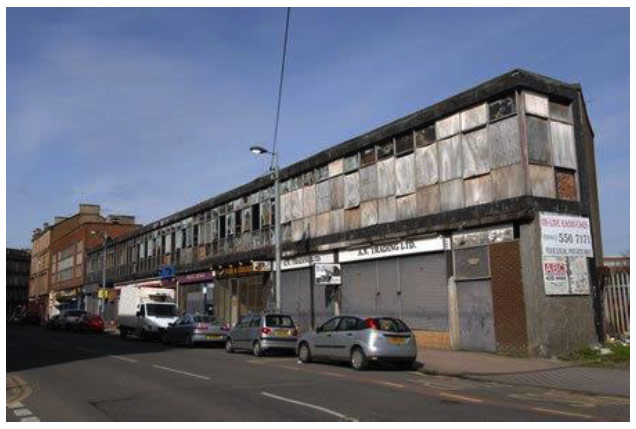
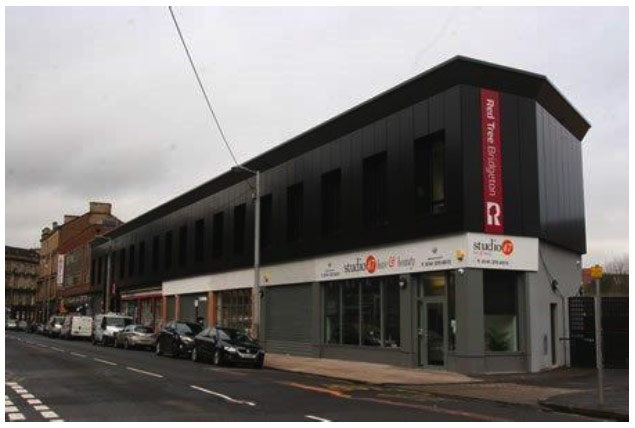
Clyde Gateway
7.28 The significant changes to the physical environment, involving extensive remediation to bring contaminated and vacant and derelict land back into use, is reflected in official statistics. Since 2008, there has been a 34% reduction in the amount of vacant and derelict land in the East End. This compares to a 12% reduction in vacant and derelict land across Glasgow over the same time period. In total, 71 hectares of vacant and derelict land in the East End have been brought back into use since 2008 (see Figure 7.3).
Figure 7.3. Total area of vacant and derelict land in the East End of Glasgow (hectares)
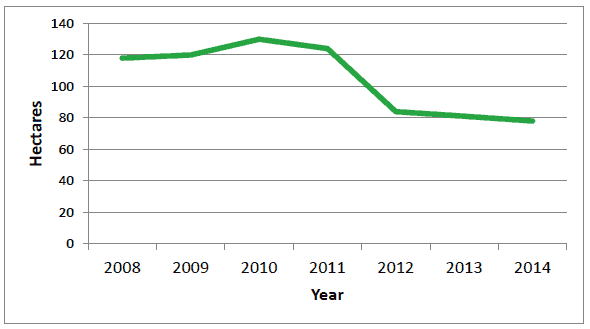
Source: Scottish Vacant and Derelict Land survey
7.29 Interventions to improve the greenspace in the East End have also progressed since 2008. Work is now well under way at Cuningar Loop with the main path network infrastructure taking shape, remediation work of the soil on site is complete and tree planting is now under way. The boardwalk, which will take visitors along each side of the Clyde, is also under construction.
7.30 Additional funding was secured via the Active Places Fund to develop a bespoke play space at Cuningar Loop that will use natural materials and landscaping to form a play space for children (see Figure 7.4). Funding has also been secured for installation of a bike skills and bouldering area onsite. Detailed planning is now under way for all the additional elements for the site.
7.31 Other environmental improvements progressed by Clyde Gateway - because of their prioritisation by the local community in consultation activity - include the Calton Burial Ground, Tullis Street Gardens and public realm improvements across the East End, in particular, at Bridgeton Cross.
Figure 7.4. Cuningar Loop before and after the development of the Commonwealth Woodland
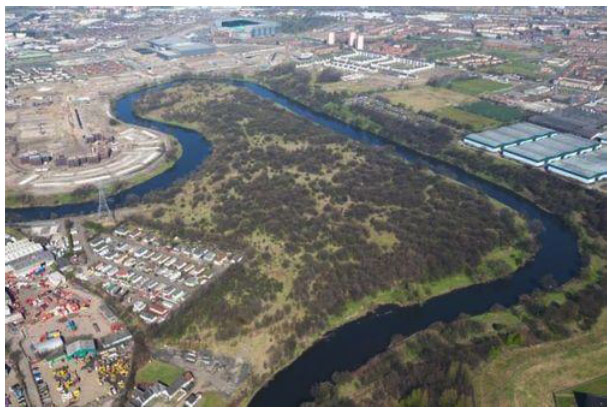
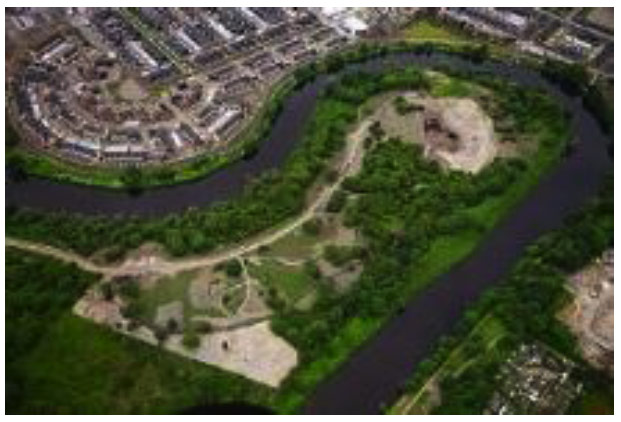
Forestry Commission
7.32 These improvements in the physical environment in the East End have been noticed by the local community. Nearly three-in-five of cohort members (59%) said that their neighbourhood had got better as a place to live in over the past two to three years, more than the 50% who said so in 2012 (see Figure 7.5). This is higher than the national rate for identifying positive neighbourhood change for those living in deprived areas, currently at 24%. Seventy-three per cent of the cohort rated the quality of local greenspace as good in Wave 1 and this increased to 76% in Wave 2.
Figure 7.5. GoWell East longitudinal cohort respondents perceived positive neighbourhood change
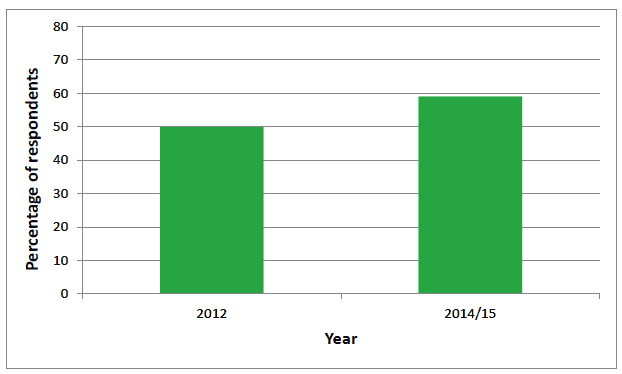
Source GoWell East: Headline indicators comparison report June 2015
7.33 Neighbourhood satisfaction also increased among cohort members between 2012 and 2014/15 (74% satisfied at Wave 1 to 78% at Wave 2). Feelings of neighbourhood safety were notably higher in the post Games sweep. Among the baseline cohort, 55% said they felt safe walking alone in the neighbourhood after dark – this increased to 64% of cohort members at Wave 2 (see Figure 7.6).
Figure 7.6. GoWell East longitudinal cohort respondents who felt safe walking alone in the neighbourhood after dark
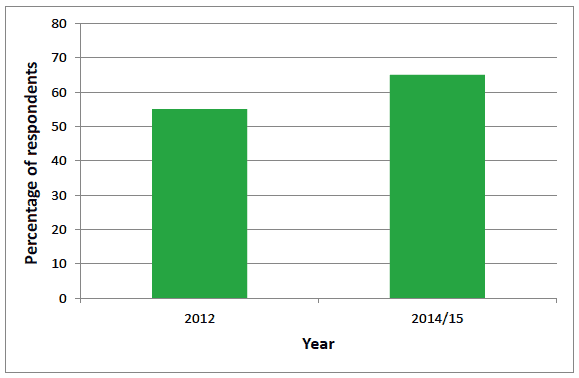
Source GoWell East: Headline indicators comparison report June 2015
7.34 Respondents’ ratings of the sports facilities in their area show positive signs of improvement. At Wave 1, 54% of the cohort said that the sports facilities in or near their local area were either ‘very good’ or ‘fairly good’. By Wave 2, this proportion was 71%.
7.35 Perception of the attractiveness of local buildings, environment and greenspace were 1%, 2% and 3% higher respectively in the longitudinal cohort post-Games compared to 2012. Conversely, perception of vacant and derelict land as a problem in the area was 8% lower (56% in 2012 compared to 48% at wave 2).
7.36 Although there is variation in the degree of change across these indicators, overall, they indicate that the cohort perceive continued positive change in the physical appearance and quality of their area; and feel safer and generally more satisfied in their neighbourhood. Nevertheless, it is clear too that cohort members recognise there is still some way to go in the regeneration of the physical environment in the East End.
7.37 Data is currently not available but in due course, comparison of the GoWell East study area to other GoWell areas should give an indication of whether the Games have brought additional benefit through associated regeneration activities.
Socio-economic environment
7.38 An issue raised in the literature on event led regeneration is that of physical displacement, often as a result of the requirement for land for event related construction. For the Glasgow Commonwealth Games, the approach taken was to use vacant and derelict land for new venue construction; refurbish existing facilities, and keep to a minimum the requirement for residential areas to be acquired for new construction.
7.39 Displacement can also occur via exertion of pressures such as changes in housing availability, house prices and jobs resulting in members of the local community experiencing pressure to move away only to be replaced by higher income groups: this social displacement is often referred to as gentrification. Gentrification takes place over time and it is too early at present to comment on this in any depth. The ecological study and further data from the GoWell East study should allow analysis of this in due course.
7.40 The Athletes’ Village provides a large element of social housing and many of the employment and other programmes were targeted to those at greatest distance from the labour market in the East End, hence efforts have been made to avoid gentrification and ensure benefits reach the East End communities.
7.41 There are indications that many in the host community in the East End have benefited from employment and training opportunities brought about as a result of the Games and wider regeneration activity. The GoWell East post Games survey found one-in-twenty cohort households had experienced employment resulting from the regeneration activity in the area over the 2012-14 period. This involved either employment in the construction of infrastructure and facilities, or subsequent employment working in those facilities. In addition, one-in-ten respondents reported employment gains (either additional employment or extra working hours) for someone in the household during the Games time in 2014.
Wider Legacy Outcomes
7.42 GoWell East also provides some insight into the extent of any change over time observed in key legacy outcomes in the East End around physical activity, engagement in culture and volunteering.
7.43 Overall, the study found that while perception of the quality of local sports facilities has seen notable positive change, use of facilities and wider reported physical activity behaviours[87] were all lower among cohort members in Wave 2 compared to Wave 1. These changes are likely to be related to the closure of some local facilities for Games related use and to the fact that fieldwork for Wave 2 was carried out in autumn/winter compared to the summer fieldwork period of Wave 1. There is evidence that physical activity decreases in adults in winter[88] thus much of the decrease may be due to seasonal variation. A clearer long term picture on physical activity among East End residents will be possible after the second follow up survey in 2016.
7.44 When asked directly about the influence of the Games on activity, some modest positive impacts were found. Eight per cent of the cohort said that they were doing more sport, or a new sport as a result of being inspired by the Games. The GoWell research team interpret this as some evidence of the operation of a ‘demonstration effect’. A further 12% of the cohort reported thinking about doing a new sport, or more sport or physical activity as a direct influence of the Games. The future survey sweep in 2016 will give insight into the extent to which this contemplation leads to behaviour change.
7.45 Finally, there are indications that attendance at the cultural events around the Games was as respondents intended. Around a quarter of the cohort (26%) said in 2012 that they intended to take part in a Games related cultural event (Culture 2014, Festival 2014, or the Merchant City Festival), and 25% subsequently reported actually taking part.
7.46 In contrast, a much lower percentage of the cohort reported getting involved in the Games as an official volunteer (3%) compared to the intention to volunteer reported in 2012 (25%).[89] Volunteering rates in general amongst the cohort (not necessarily related to the Games) increased, however, between waves 1 and 2, from 26% to 29%, suggesting that respondents found other ways to volunteer. This may have been through multiple legacy programmes or general opportunities to volunteer in the community.
7.47 Finally, evidence from the evaluation of the Glasgow 2014 Cultural Programme suggests it provided a catalyst for increased social and cultural events and engagement in the East End, an area which has traditionally been underserved in terms of cultural events compared to the city centre or West End. East End Social, a project by East End based record label Chemikal Underground, combined community events in schools, care homes, libraries and local churches with larger concerts such as the Last Big Weekend Festival.
Disruption of the event
7.48 The literature review highlighted how, despite often positive changes overall, in the short-term events of this scale can lead to disruption for local communities. Construction associated with major events and Games time disruption related to traffic and spectator management at venues can notably impact on residents’ daily lives.
7.49 East End cohort members clearly experienced Games time disruption and inconvenience – mainly related to transport, parking and security arrangements around the Games. In total, 72% of cohort respondents reported one or more inconvenience from the Games.
7.50 Nevertheless, a clear majority (77%) of those cohort members who experienced inconvenience said they thought it was worth it for the enjoyment or benefit the Games brought. As in Scotland, and across Glasgow, the level of support for hosting the Games remained high in the post Games time. 81% of the cohort said they were supportive of the Games in Wave 2.
Contact
Email: Niamh O’Connor
There is a problem
Thanks for your feedback